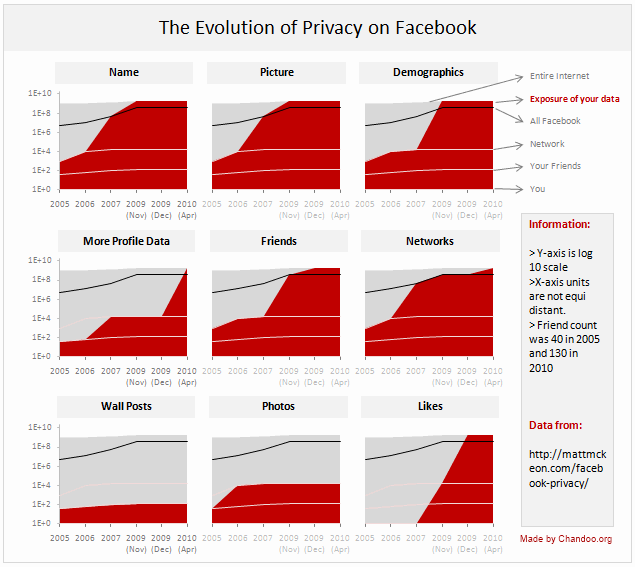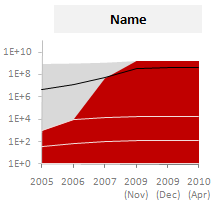There is a chart called “Evolution of Privacy on Facebook” going around on the web. The chart made by Matt Mckeon, a developer in IBM’s visual communications lab has created quite a stir in the interwebs. You can a small animated version of that chart below:

While Matt made a few mistakes with the chart, I think this is a stunning way to depict how facebook privacy policies have changed since 2005.
(How to read the above chart: It is radar-like chart, with logarithmic scale for spoke axis. The concentric circles depict number of people – inner most is you, then your friends, friends’ friends, entire facebook and entire internet. Privacy is measured on 9 areas – Name, Picture, Demographics, Extended Profile Data, Friends, Networks, Wall posts, Photos, Likes of you. A portion of the radar is shaded blue if that information is available to that portion by default.
For eg. in 2005 what you liked (likes) is known only to you. But, by 2010 entire internet can know what you liked.
Also, the data is based on Matt’s observations. More…)
I liked this chart and challenged myself to build the same in excel. Then as I was exploring the data (hidden inside the source code of his visualization), I had a better idea. “Why not make a panel chart“.
So I made this,
Evolution of Privacy Policies on Facebook

[click here for a larger version]
How to read this chart?
 Each panel depicts how privacy policies have changed for one area of privacy since 2005 to 2010. So, for eg. if you are looking at the “Name” panel,
Each panel depicts how privacy policies have changed for one area of privacy since 2005 to 2010. So, for eg. if you are looking at the “Name” panel,
- Your Name was visible only to 1000 people in 2005 but in 2010, Entire internet (1.8 Billion) can see your name on Facebook.
- The dull gray color portion shows entire Internet population (it grew from 1B in 2005 to 1.8B in 2010).
- Red color portion shows how much of internet population can get your data from Facebook.
- The y-axis is log 10 scale, meaning each increment in y-axis value is actually 10 times more than previous value.
- The 3 lines indicate your friends, network and entire face book users respectively. Facebook users is shown on top in black color.
How is this chart made?
- After downloading the source code of original visualization by Matt, I just copied the data points from code to excel.
- Then I cleaned and transposed the data so that area charts can be made.
- The chart panels are combo-charts with both areas (red and gray portions) and lines (facebook, network, friend counts).
- Once made the first chart, I just duplicated it 8 more times and changed source points. (press CTRL+D to duplicate).
- A little bit of alignment and formatting to make it look clean and simple. [chart alignment tip].
Known issues in this chart:
- The horizontal axis (dates) are not equally spaced. The measurement times and accuracy are unknown.
- I am not 100% sure if areas are a good way to depict such data. But they seem ok to me.
Download the Excel File:
Click here to download the excel file [Excel 2007 version here] with facebook privacy policies excel panel chart. Play with it a bit to understand how it works.
How would you improve or visualize such data?
I used time as the axis and privacy areas as panels since the message is “how privacy policies have changed since 2005”. But I am sure you would love to explore this data in a different way. Go ahead and get the download file and make your own charts. Then share them using comments.
Also, suggest alterations or your impressions on this chart. Discuss.


















6 Responses to “Using Lookup Formulas with Excel Tables [Video]”
H1 !
this is my very first comment.
Can you use same technique with Excel 2003 lists ?
thanks 😀
Thanks, Chandoo! I like seeing the sneak peak of what's to come on Friday too 🙂
@Damian.. Welcome to chandoo.org. Thanks for the comments.
Yes, you can use the same with Excel 2003 lists too.
@Tom.. You have seen future and its awesome.. isnt it?
[…] Using Tables – Video 1, Video 2 […]
[…] Using Tables – Video 1, Video 2 […]
Hi, is there a vlookup formula for the second example (IDlist)? I used a similar formula to look up the ID for the person, but the reverse way (look up the person with the ID) comes up N/A.